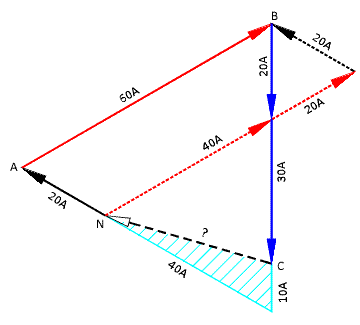This question was on the PE exam. The neutral current is the sum of all the currents on each leg (phase), so therefore it would be Ia<-45 + Ib<-30 +Ic<-45. You must use the phase angle with positive and neg., with cos and sine. The reason is because some phases are lagging, and some are leading. This is why your P.F. for each phase is different.
With that said, if the loads were balanced, the sum of Ia<-45 + Ib<-30 +Ic<45 would equal zero, but as you already know the neutral carries the unbalanced current when the load is unbalanced.
Sorry, this was something they drilled into us on the PE exam, and there were 5 questions on this alone. Thank God that horrible test is over....selling circus peanuts, here we come! LOL
Lady, you must reference the phase angles to the phase voltages. For example, the angles 0, 120, and 240 yield the following equations.
Ia<-45 + Ib<90 + Ic<285 = In



